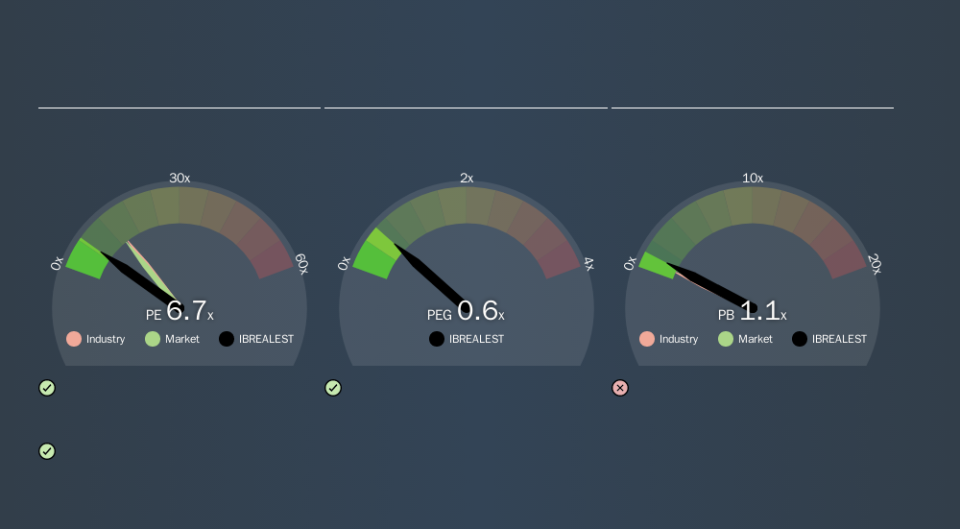A Rising Share Price Has Us Looking Closely At Indiabulls Real Estate Limited's (NSE:IBREALEST) P/E Ratio

Indiabulls Real Estate (NSE:IBREALEST) shareholders are no doubt pleased to see that the share price has bounced 77% in the last month alone, although it is still down 7.7% over the last quarter. But shareholders may not all be feeling jubilant, since the share price is still down 22% in the last year.
All else being equal, a sharp share price increase should make a stock less attractive to potential investors. While the market sentiment towards a stock is very changeable, in the long run, the share price will tend to move in the same direction as earnings per share. The implication here is that deep value investors might steer clear when expectations of a company are too high. One way to gauge market expectations of a stock is to look at its Price to Earnings Ratio (PE Ratio). Investors have optimistic expectations of companies with higher P/E ratios, compared to companies with lower P/E ratios.
Check out our latest analysis for Indiabulls Real Estate
Does Indiabulls Real Estate Have A Relatively High Or Low P/E For Its Industry?
We can tell from its P/E ratio of 6.69 that sentiment around Indiabulls Real Estate isn't particularly high. If you look at the image below, you can see Indiabulls Real Estate has a lower P/E than the average (13.9) in the real estate industry classification.
This suggests that market participants think Indiabulls Real Estate will underperform other companies in its industry. Many investors like to buy stocks when the market is pessimistic about their prospects. It is arguably worth checking if insiders are buying shares, because that might imply they believe the stock is undervalued.
How Growth Rates Impact P/E Ratios
Generally speaking the rate of earnings growth has a profound impact on a company's P/E multiple. If earnings are growing quickly, then the 'E' in the equation will increase faster than it would otherwise. Therefore, even if you pay a high multiple of earnings now, that multiple will become lower in the future. Then, a lower P/E should attract more buyers, pushing the share price up.
Indiabulls Real Estate saw earnings per share decrease by 75% last year. But over the longer term (5 years) earnings per share have increased by 26%.
A Limitation: P/E Ratios Ignore Debt and Cash In The Bank
One drawback of using a P/E ratio is that it considers market capitalization, but not the balance sheet. So it won't reflect the advantage of cash, or disadvantage of debt. Hypothetically, a company could reduce its future P/E ratio by spending its cash (or taking on debt) to achieve higher earnings.
Spending on growth might be good or bad a few years later, but the point is that the P/E ratio does not account for the option (or lack thereof).
Indiabulls Real Estate's Balance Sheet
Indiabulls Real Estate's net debt is considerable, at 161% of its market cap. This level of debt justifies a relatively low P/E, so remain cognizant of the debt, if you're comparing it to other stocks.
The Bottom Line On Indiabulls Real Estate's P/E Ratio
Indiabulls Real Estate has a P/E of 6.7. That's below the average in the IN market, which is 13.4. Given meaningful debt, and a lack of recent growth, the market looks to be extrapolating this recent performance; reflecting low expectations for the future. What is very clear is that the market has become less pessimistic about Indiabulls Real Estate over the last month, with the P/E ratio rising from 3.8 back then to 6.7 today. If you like to buy stocks that could be turnaround opportunities, then this one might be a candidate; but if you're more sensitive to price, then you may feel the opportunity has passed.
Investors have an opportunity when market expectations about a stock are wrong. As value investor Benjamin Graham famously said, 'In the short run, the market is a voting machine but in the long run, it is a weighing machine. So this free visualization of the analyst consensus on future earnings could help you make the right decision about whether to buy, sell, or hold.
Of course, you might find a fantastic investment by looking at a few good candidates. So take a peek at this free list of companies with modest (or no) debt, trading on a P/E below 20.
We aim to bring you long-term focused research analysis driven by fundamental data. Note that our analysis may not factor in the latest price-sensitive company announcements or qualitative material.
If you spot an error that warrants correction, please contact the editor at editorial-team@simplywallst.com. This article by Simply Wall St is general in nature. It does not constitute a recommendation to buy or sell any stock, and does not take account of your objectives, or your financial situation. Simply Wall St has no position in the stocks mentioned. Thank you for reading.


